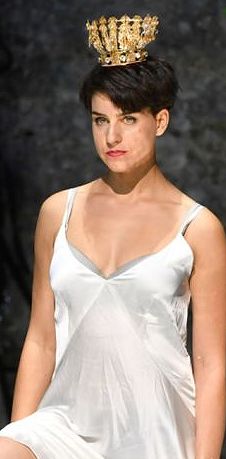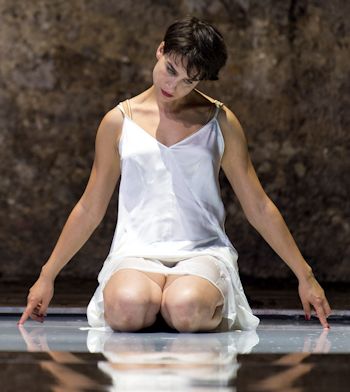Salome as directed by Romeo Castellucci
An interpretation by Len Mullenger
Castellucci has come up with a peverse, imaginative, striking and
disturbing new production of Salome that at first had me shaking my
head and declaring ‘rubbish!’. I only stuck with it because of the absolutely
riveting characterisation by Asmik Grigorian. But as I pondered on it
and started reading other people’s reviews I came to a more sympathetic
conclusion and feel that other commentators have been rather too timid.
Narraboth and the Page open the proceedings by walking slowly in step
onto the stage and eventually point to the moon which is the cue for
the Opera to begin. Their most striking feature is that the lower halves
of their faces are painted red. Later we will see the King and his followers
also have red faces. However, Herodias has a green face and Salome does
not have a painted face at all. I think the colour is a tribal sigil
rather like a living coat-of-arms. If there was a coat-of-arms, Herod’s
side would be all red as they are ‘related’, Herodias would have her
own family sigil which in this case is green. If it were a coat of arms
they would be side by side (quartered). Salome would have both colours
on her coat of arms eventually but at sixteen is not yet old enough.
The Jews' sigil are their hats. 
At her first entrance Salome runs on looking terrified saying that
she cannot bear to stay here any longer “Why does the Tetrarch keep
looking at me that way?” “It is strange for my mother’s husband to look
at me like that” She has come in from a dark place and declares how
good it is to see the moon. This is a tale of a young teenager who has
been subjected to sexual depravity, probably for several years because
we later meet two Salomes. One is a young girl of about 11 who represents
the unsullied after which, presumably, the abuse began. Having rushed
on to the stage Salome turns and we can see that her white gown is blood-stained
at the back. Other commentators have said this is menstrual blood but
a 16 year old is capable of coping with that. This is much worse. Salome
has been abused by Herod and we are seeing rectal blood.
She hears the Prophet and learns that he is a young man and is desperate
to speak to him – NOW please! We see Salome as a petulant teenager.
She knows Herod has forbidden this but that just drives her on. Poor
Narraboth is subjected to persuasion and manipulation and eventually
succumbs. All this has happened quite rapidly but in this short time
Asmik Grigorian, who is quite passable as a sixteen year old, has shown
the enormous range of her acting abilities. She is totally captivating
for the whole of the opera and her singing ability is just as magnificent.
When Narraboth says he cannot give her what she wants because Herod
has strictly forbidden it she pulled the sort of face parents of all
teenage girls will recognize – an incredulous “Oh Really – you reckon?”
She then uses all her wiles to successfully persuade him to do what
she wants.
In the background we see the first body being dragged in a bag. This
is never satisfactorily explained but Salome has said she hates the
Romans because thay are so rough so is this the result of a Roman sword?
We certainly go on to see more as time passes, some still alive, some
dismembered – symbols of a degenerate court. Knowing she is now
going to meet Jochanaan she places her crown on her head and puts on
her cape, shoes and gloves to make herself as appealing as possible
to him. As a black moon rises she is already infatuated with the idea
of the prophet whom she has never seen. He is actually not very becoming
as he rises from the black pit covered in slime, becoming visible in
the centre of the black moon. Salome’s infatuation means she does
not see him as he really is, indicated by the projection of a gauze
over his face. This gauze will become a persistent feature of the  production.
At the back of the stage a saddle, stirrups and reins are neatly arranged.
To Salome, Jochanaan appears as chaste as the moon and she wants to see
him more clearly. She performs a little girlish dance for him but he
forbids her to speak to him. His voice is music to her ears. As she
declares she is in love with him the black moon gets bigger and bigger
eventually engulfing her. Although he is filthy black she deludedly
maintains there is nothing in the world as white as his body. Jochanaan
curses her and retreats back into his cistern.
production.
At the back of the stage a saddle, stirrups and reins are neatly arranged.
To Salome, Jochanaan appears as chaste as the moon and she wants to see
him more clearly. She performs a little girlish dance for him but he
forbids her to speak to him. His voice is music to her ears. As she
declares she is in love with him the black moon gets bigger and bigger
eventually engulfing her. Although he is filthy black she deludedly
maintains there is nothing in the world as white as his body. Jochanaan
curses her and retreats back into his cistern.
At every stage Salome is rejected and eventually this twists and distorts
her mind. She wants to touch his body but is told to “Get back,
daughter of Babylon, Evil came into this world by woman” In her
anguish she declares that his body is now hideous like the body of a
leper and she projects this onto poor Narraboth who gets physically
pulled about with his arms and wrists being twisted and he is finally
cast to the ground. No, in fact, it is Jochanaan’s hair that she
loves, like black bunches of grapes, black like the long black night
when the moon hides her face. Salome is being subjected to mental torture
and, adopting an anguished pose, she pleads to be able to touch his
hair but, once again, she is rejected. Your hair is horrible she now
declares, wrapping herself in the horse's reins from the back of the
stage. It is like a crown of thorns on her head, a knot of black snakes
writhing round her neck. In a vocal tour de force she decides it is
not his hair she wants but his mouth, which is like a band of scarlet
on a tower of ivory. The black moon gets bigger and bigger and Salome
is covered in a projected gauze ending up glistening white in a spot
of light on a huge black stage. How does one project black? Jochanaan
and Salome are now very close. He is tall and standing directly behind
her like a huge black bird with she in front, a diminutive, vulnerable
but by now deranged fanatic demanding to kiss his mouth. She turns to
face him and he puts his arms around her holding her crown and veil
declaring that he will never let her kiss him.
The black moon recedes and in a final attempt to appeal to Jochanaan’s
sexuality she kneels and places the horses saddle on her back rolling
forward onto her palms indicating that she is fully sexually available.
Jochanaan does not even notice but curses her as the daughter of an incestuous
mother and he descends back into the pit. Salome collapses onto her
back and with her legs in the air performs orgasmic, gymnastic movements
with her legs. This is all part of the smouldering sexual undertone
the producer has decided is the only way to approach this work. Herod
arrives looking for Salome who scarpers. It is still dark so his way
is lit by by a number of portable drawing-room standard lamps. I must
admit I found this risible until I realised this is Castelluci's update
of men carrying flaming torches for light in the same way that everyone
is wearing suits and not robes or guard uniforms.
This
brings us to the huge black horse that appears in the cistern. I believe
this is more than just another representation of Jochanaan that some
have suggested. Many young girls, before they are even aware of boys
and romantic love find they are capable of an innocent love they develop
for their pet horses. They are able to whisper all their secrets and
pour out their troubles where no-one can hear. Young as they are, here
is a huge creature over which they can exert power and control and yet
love at the same time. They are not rejected in this but their love
is returned unconditionally. The horse represents Salome’s unconditional,
pre-Herod love which will become shattered by Herod’s abuse leading
to the perverted love she has developed for Jochanaan. This loss of early
innocence is symbolised by the decapitated horse’s head that precedes
the loss of Jochanaan’s head.
During the argument between Herod and the Jews, Jochanaan is hosed
down to remove all the black filth so he emerges as white as Salome’s
vision of him. Realising that Herod is willing to reward her with anything
she asks, Salome agrees to dance. This is Castellucci greatest innovation
and challenge to the audience as there is no Dance of the Seven veils
– at least not publically. Instead a semi-naked Salome is positioned
on a huge stone adopting an upright foetal position on her knees with
her head under her arms and is held there by a black ribbon. This is
a bondage situation where she is fully available for Herod to do his
worst – but he alone. Far from dancing she remains motionless for several
minutes, the only motion being the flickering gauze and a slowly descending
rock cage which ends up covering or obliterating her and hiding her
from our view. The dance continues in the orchestra and at its climax
Salome staggers out in a tortured and distressed state frantically tugging
up her dress and flinching from human touch. We can guess what has been
going on. She demands Jochanaan’s head on a silver platter. She is again
dressed in her crown, standing in a pool of virginal milk but gives
a one-finger salute to Herod as he tries to wheedle his way out of his
sworn oath. The decapitated horse's head is placed with her. Herod pleads
but Salome ignores him, writing frantic messages in the pool of milk.
We enter the final scene of totally deranged horror but instead of
the head she desires she only receives Jochanaan’s torso. She is not
able to kiss his mouth but she can climb and sit on his torso and plants
her crown on the stump. She is now an unstable psychopath whose only
fate is to be destroyed. On the wall at the back of the stage large
gold letter have been spelling out Iω ΠρO for
Ió[annés] pro[phétés], John the prophet.
The other letters have now been taken down leaving just the large Greek
Omega – symbolising the End.
If only you had looked upon me you would have loved me!

Photo credits: © Salzburger Festspiele / Ruth Walz
Asmik Grigorian is the daughter of the Armenian tenor Gegham Grigoryan
(1951–2016) and the Lithuanian soprano Irena Milkeviciute (b. 1947).
Strauss, R: Salome
Wiener Philharmoniker
Franz Welser-Möst
Asmik Grigorian (Salome), John Daszak (Herod), Anna Maria Chiuri (Herodias),
Gábor Bretz (Jochanaan), Julian Prégardien (Narraboth)
Salzburg Festival, Grosses Festspielhaus, August 2018
Unitel: Blu-ray 801704, DVD 801608
Reviews:
Roy
Westbrook
William
Hadley
John
Quinn (last item in the PDF file)
